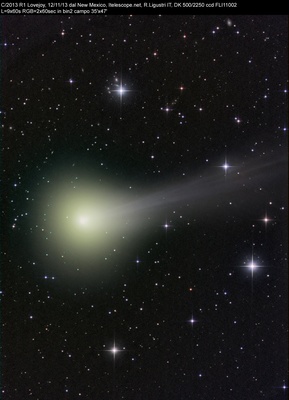This comet is brighter than ISON
The comet's pale green atmosphere is almost twice as wide as the planet Jupiter, and there are no fewer than three tails streaming behind the comet's nucleus. Sky watchers in dark sky sites say that can now see this lovely comet as a faint smudge using averted vision--no optics required. A telescope is, however, recommended.
Comet Lovejoy is one of four comets now rising in the east before dawn. The other three are exploding Comet LINEAR X1, sungrazing Comet ISON, and short-period Comet Encke, and the brightest of them all. All four are easy targets for backyard optics. Dates of special interest include Nov. 15-18 when Comet LINEAR X1 passes by the bright star Arcturus, Nov 17-18 when Comet ISON has a close encounter with Spica, and Nov. 18-20 when Comet Encke buzzes Mercury. These stars and planets make excellent naked-eye guideposts for finding the comets. Meanwhile, bright Comet Lovejoy is approaching the Big Dipper; if you can't see it with your unaided eye, a quick scan with binoculars will reveal it.
